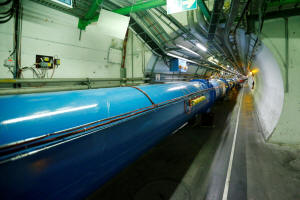|
The
27 kilometre-long (16.8 mile) LHC at CERN is the machine that
found the Higgs boson particle, which along with its linked
energy field is thought to be vital to the formation of the
universe after the Big Bang 13.7 billion years ago.
Now scientists at CERN say they have observed a new kind of "pentaquark"
and the first-ever pair of "tetraquarks", adding three members
to the list of new hadrons found at the LHC.
They will help physicists better understand how quarks bind
together into composite particles.
Quarks are elementary particles that usually combine in groups
of twos and threes to form hadrons such as the protons and
neutrons that make up atomic nuclei.
More rarely, however, they can also combine into four-quark and
five-quark particles, or tetraquarks and pentaquarks.
"The more analyses we perform, the more kinds of exotic hadrons
we find," physicist Niels Tuning said in a statement.
"We're witnessing a period of discovery similar to the 1950s,
when a 'particle zoo' of hadrons started being discovered and
ultimately led to the quark model of conventional hadrons in the
1960s. We're creating 'particle zoo 2.0'."
(Reporting by Michael Shields; Editing by Catherine Evans)
[© 2022 Thomson Reuters. All rights
reserved.] Copyright 2022 Reuters. All rights reserved. This material may not be published,
broadcast, rewritten or redistributed.
Thompson Reuters is solely responsible for this content.

|
|




